A single day group tour down in the Fens, listening to and watching Nightingales and then looking for other spring Fenland specialities. After a slightly damp, cool and cloudy start, the sun came out and it was a lovely warm sunny day. Perfect birding weather.
We met this morning in the car park at Lynford Arboretum and headed off into the Fens from there. At our first stop, we got out and while everyone was getting ready we had a quick scan of the neighbouring fields. It didn’t take long to find a Stone Curlew and then we realised there were another two nearby. They were no particularly close but we got them in the scope for a good look at them.
As we walked down the road, we could hear lots of birds singing. Garden Warbler and Blackcap would accompany us for most of the morning and gave us a good chance to listen to the differences between the two songs. Common Whitethroats were scratching away and one flew up to sing in a tree above us. We could hear the sweet descending scale of a Willow Warbler and a couple of Chiffchaffs doing what it says on the tin. A male Yellowhammer flew up into the bushes and we could hear others singing of bread and cheese.

It didn’t take long to hear the wonderful flutey notes and whistles of our first Nightingales. They were keeping tucked down a bit this morning, perhaps because it was still rather cloudy here. We couldn’t see them in the dense undergrowth but it was a joy just to stand and listen to them. There were at least 4 males singing just as we walked down the road.
It seemed to be brightening up a little so we cut in along a smaller path. Another Yellowhammer flew across ahead of us and we stopped to look at a Willow Warbler singing in the top of a large hawthorn. We could hear another Nightingale singing in the distance, so we headed over to see if we could get a look at that one.
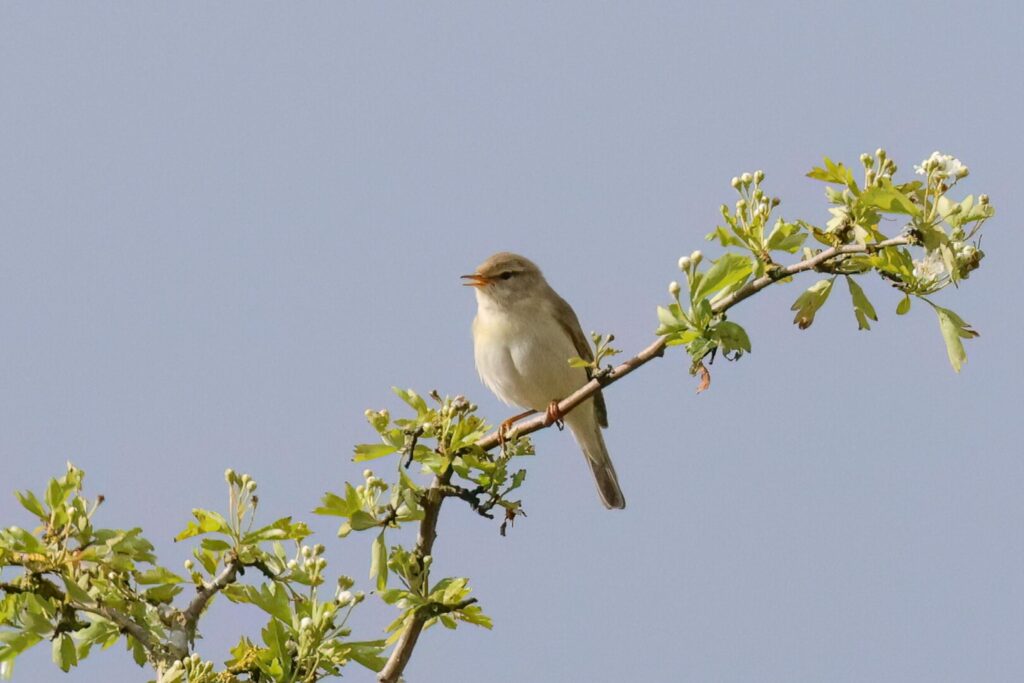
The Nightingale had gone quiet by the time we got there, but we walked over to the bushes where it normally likes to sing from, next to one of the tracks. We had just arrived when it started up again. The hawthorns here are in full leaf and flowering, so again it was hard to see. We had some glimpses of it, but it seemed to know we were there and after a short while it went quiet. Of course, as soon as we walked away, it started up again!
We walked round through another Nightingale territory, but the birds here are already paired and the male is quieter now. Thankfully, there were another two Nightingales singing just beyond and as we came out of the bushes we could see one perched in the top of its favourite bush in full view. We got it in the scope and could see it singing, its bill opening and closing in time to the music and its tail quivering with the effort.

The Nightingale was face on to us at first, then turned to show off its rufous-brown upperparts and orangey tail. It seemed very settled but then some dogwalkers walked out from behind the bushes and it flew further back, out of view. Nice views, and mission accomplished, we set off further round to see what else we could find.
There were more warblers singing from the bushes and we heard a very distant Cuckoo briefly. A Lesser Whitethroat rattled a couple of times ahead of us but had gone quiet by the time we got closer. A young Roe Deer buck stared back at us from the grass.
As we approached another area of trees and bushes we could hear another Nightingale singing and had a couple of glimpses of it in the undergrowth. As we walked in along a small path, a second Nightingale started up and as we stood and listened we realised we were actually sandwiched right between three singing males!
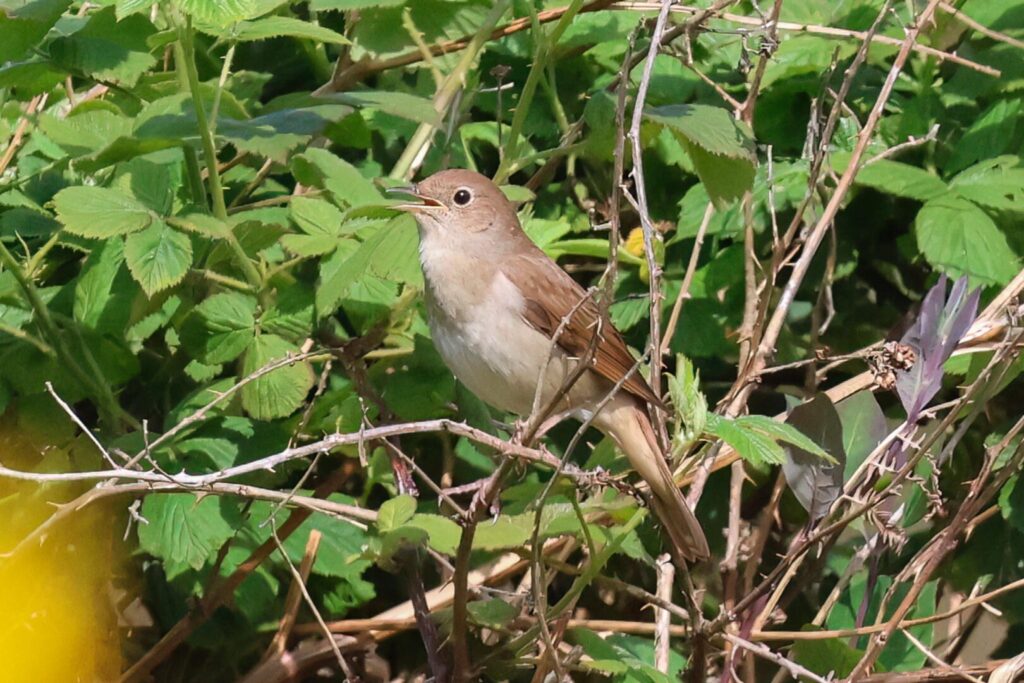
The Nightingales were moving around us as they sang. One flew in and landed in the base of the brambles right behind us, hopping in on the ground. Then one flew up and landed in some brambles where it started singing in full view. The third, not to be outdone, then flicked up into an elder right in front of us. We had some really nice views of them now. It was great to watch them and to listen to them all singing against each other.
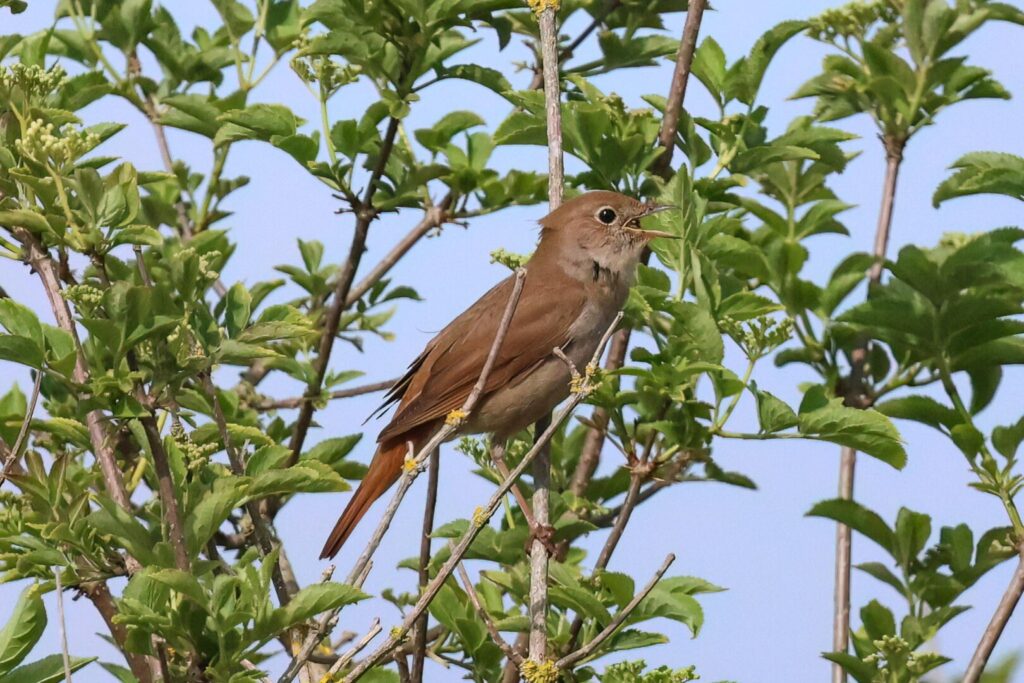
After such a fantastic performance from the Nightingales, we continued our way back along the track to the car park. A couple of Bullfinches called from the trees but we couldn’t see them. A few Speckled Yellow moths flew round over the bushes but wouldn’t land. While we loaded up the minibus, we had another quick look at the Stone Curlews, which were still over at the back of the field. Two started to display to each other, bowing – great to watch.
We drove over to the RSPB reserve at Lakenheath Fen next, where the car park was surprisingly busy. The good weather seemed to have brought out lots of people! After checking in at the Visitor Centre, we had a quick look at the pool behind. A pair of Coot were feeding their red-headed juveniles on the water and a Grey Heron flew in and stalked along the back shore. A Reed Warbler was singing rhythmically from the reeds. There were a few birds on the feeders – Reed Buntings, Greenfinch and a smart male Siskin.
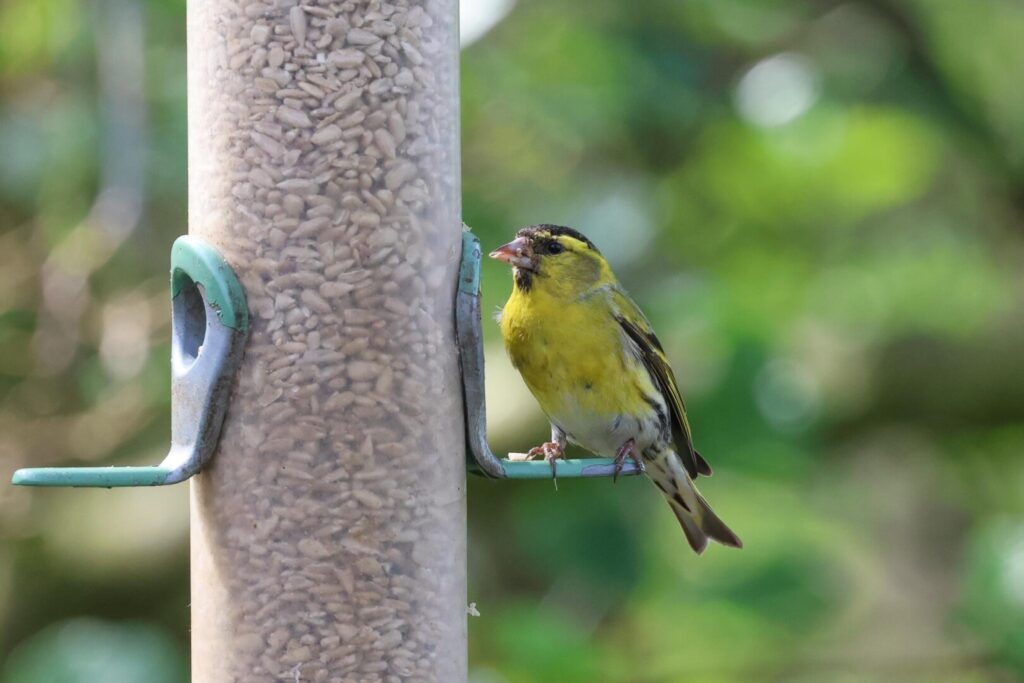
As we walked out along the main track, a Nightingale was singing from the sallows. We had really been spoilt for them today, and this one wasn’t likely to show like the ones we had seen earlier, so after stopping to listen for a bit we pressed on. A male Common Whitethroat launched itself in song flight across the and landed in the top of the sallows. A Cetti’s Warbler shouted from deep in cover. A Cuckoo was calling from somewhere the other side of the railway and a pair of Lapwings were displaying over the fields.
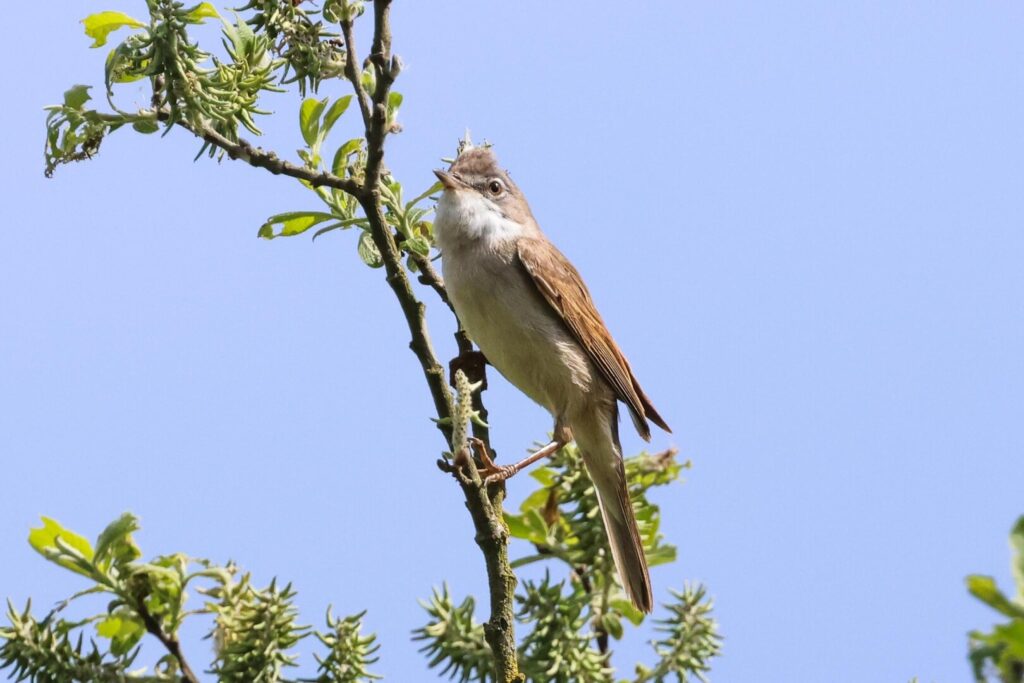
We stopped at New Fen Viewpoint and were quickly on to a couple of Hobbys. We watched them hawking for insects, flies and dragonflies, over the reeds. A female Marsh Harrier circled up and then dropped back in shortly after with a fresh piece of nest material. There were a few geese, a pair of Tufted Ducks, some Coot and a Little Grebe on the pool. A Bittern boomed several times from somewhere deep in the reeds.
Before everyone got too comfortable, we set off again, taking the path along the top of the bank so we could see over the reeds. There were at least four Hobbys now and a couple came a bit closer, hawking at one point high over our heads. A male Marsh Harrier circled up out of the reeds now.
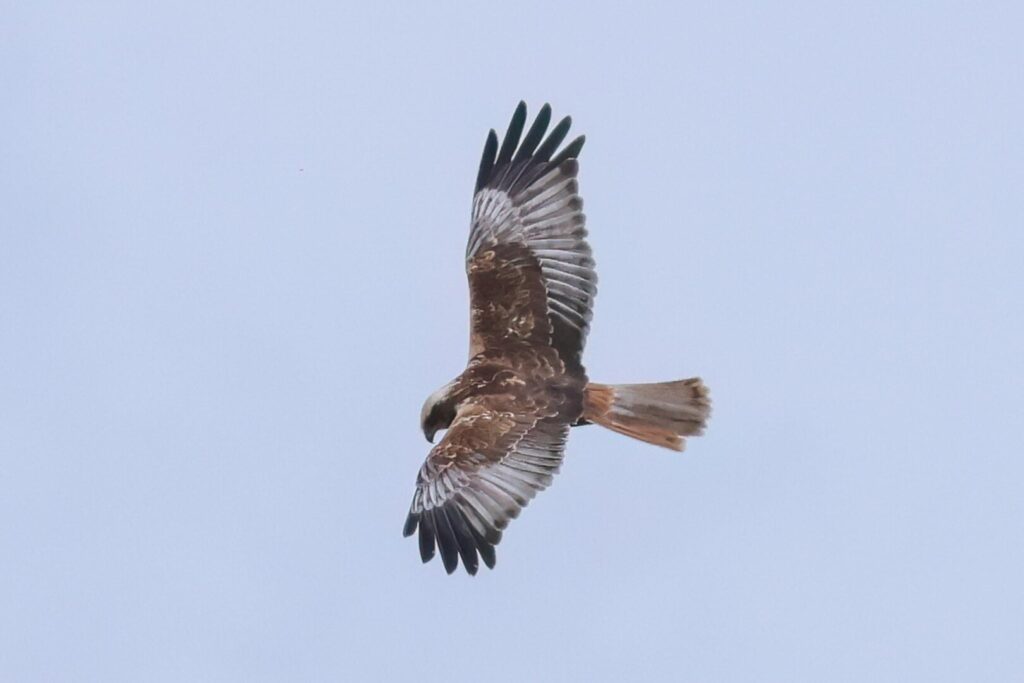
Another Little Grebe was on one of the pools in the reeds and a couple of Great Crested Grebes were on another. We scanned the edges of the reeds for Bitterns but we were not in luck here today.
Clouds of damselflies came up from the vegetation as we walked through. They looked to be mostly freshly emerged Azure Damselflies but one mature blue male had a noticeably dark thorax and when it landed we could see it was a Variable Damselfly. There were a few Hairy Dragonflies on the wing too and one landed in the nettles close to the path.
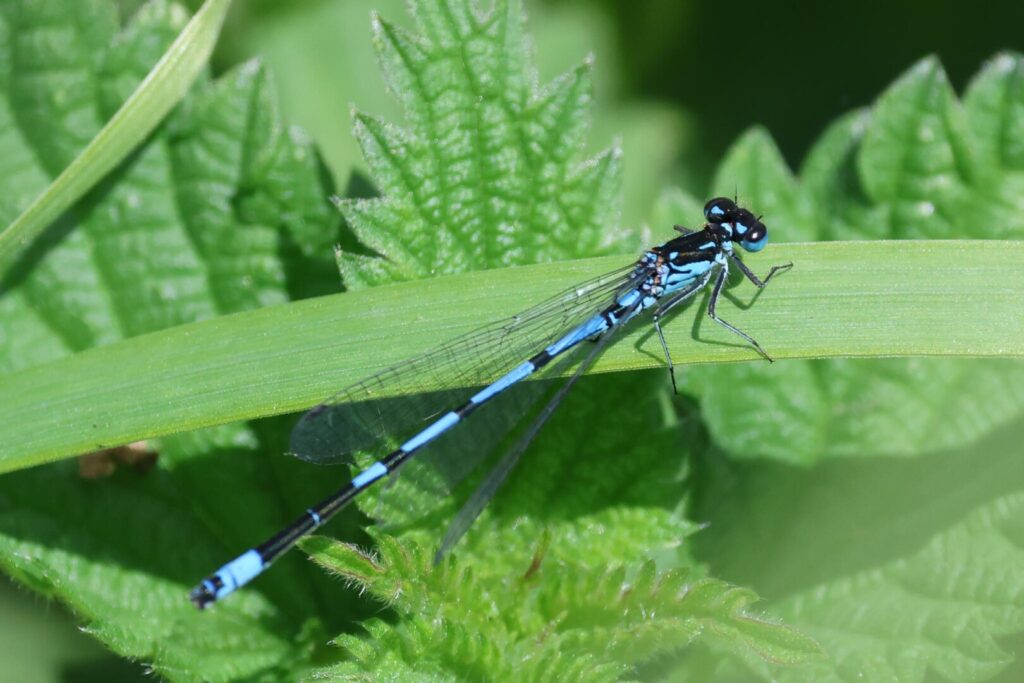
A little further on, we stopped to listen to a Sedge Warbler singing and compared its more chaotic song with the more regular rhythm of the numerous Reed Warblers. The warblers are all in in good numbers now, although the Sedge Warblers seem to have gone a little quiet at the moment. A Cuckoo called in West Wood but it was too deep in to see as we passed.
A pair of Greylag Geese with four goslings had taken up residence by one of the benches and several other pairs flew back and forth. Four Common Pochard were diving in one of the pools by the track. We pressed on to Joist Fen Viewpoint now where we sat down to eat our lunch and take in the view.
There were lots more Hobbys in the air out over Joist Fen, though mostly distant. We counted at least 21 in the air together at one point, but they seemed to be coming and going so there were probably more. Several Marsh Harriers circled up too.
One of the group picked up two large birds flying in over the back, two Bitterns! They seemed like they might have come from across the river and flew out across Joist Fen, where they circled. One eventually dropped down into the reeds and the other seemed to fly further back. Not long after, we turned to see another Bittern flying past. We watched this one fly away from us out over the reeds before dropping in further back.
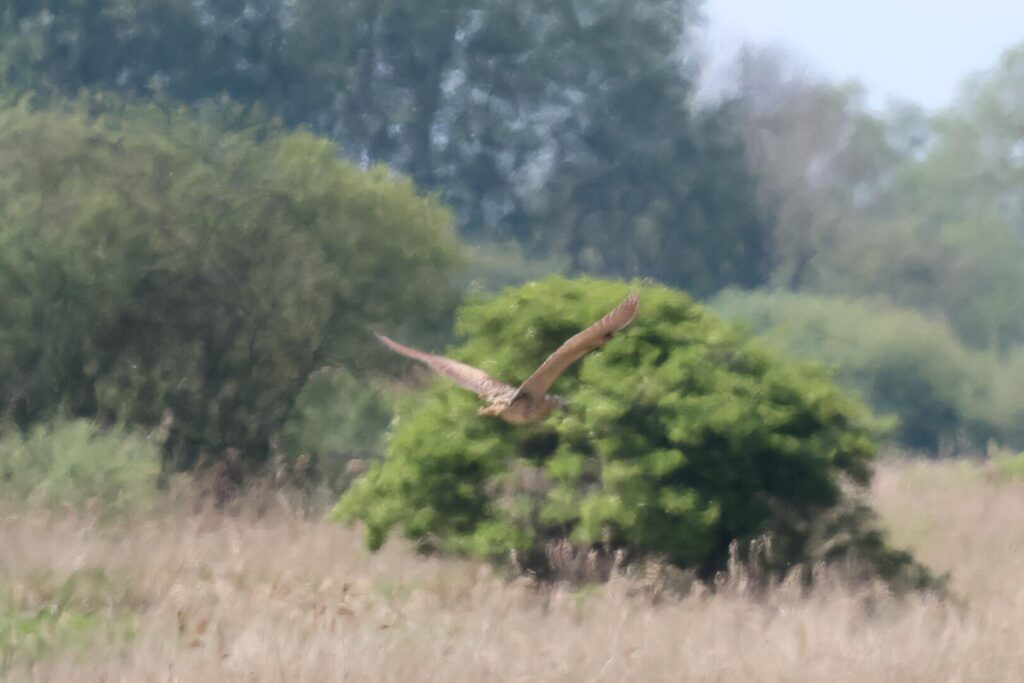
There were a few Shoveler out on the pools in the reeds and a Little Egret. A couple of Lapwings flew up from time to time and a Redshank flew off behind us and presumably the same then flew back in calling a minute later. A Cormorant eventually landed on the post where one normally stands. A dragonfly flew past the benches and landed on the edge of the reeds nearby – our first Four-spotted Chaser of the year.

It is a lovely place to sit and take in the view here, particularly on a sunny afternoon as it was now. After we had finished eating, we continued to watch and scan for a bit. We kept checking the paddocks in particular, hoping for a Common Crane, and our persistence eventually paid off when we picked up the head of a Crane in the back of the reeds.
The Cranes can be more elusive in the breeding season, so this was a real bonus. It didn’t stay long though, walking out into a slightly more open spot so we could get a better view of it then disappearing behind a bush. Not long after it walked back into view the other side, it took off and flew a short distance before landing where we couldn’t see it.

With all the main birds we could hope to see here now seen, and lunch packed away, we decided to start making our way back. There were a couple of Hobbys now hawking over the path so we had great views as we walked along, almost falling over as they flew right over our heads.
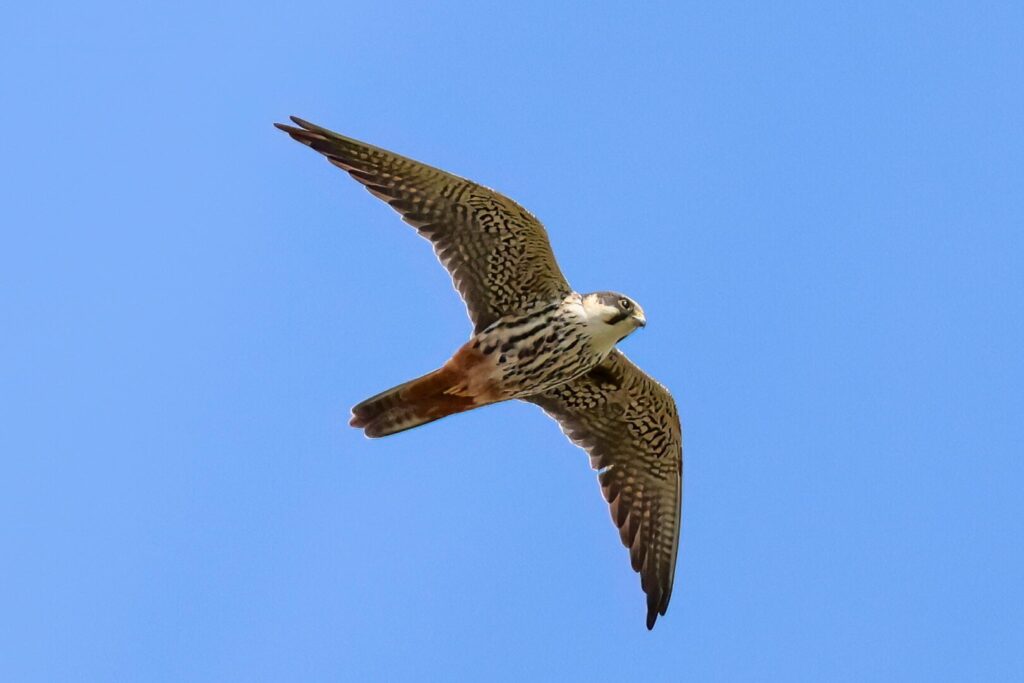
A couple of different Reed Warblers were feeding on the edges of the reeds and we managed to get eyes on them now for the first time today. As we got back to West Wood, we could hear the Cuckoos calling on our side of the poplars now. We saw two birds chasing each other through the trees and had several nice if brief views of them perched in branches.
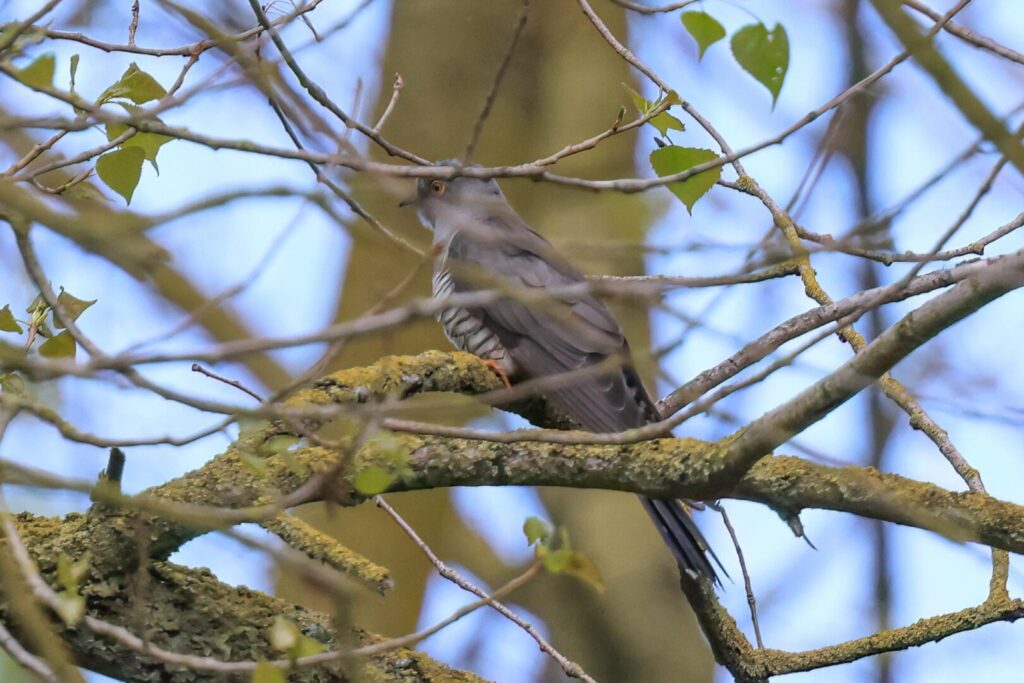
The Nightingale was still singing in the sallows as we passed. We continued on past the Visitor Centre and out to the Washland viewpoint for a quick look across at Hockwold Washes. A Great White Egret was patrolling the shallows and there were several ducks out on the water including a Shelduck and a few Wigeon which were both new for the day’s list.
We had tired everyone out after the long walk out to Joist Fen and back, so we decided to head back to Lynford now for a quick – short – walk before it was time to finish. The car park was a lot busier than it had been first thing this morning but thankfully it looked like it was already starting to thin out and we didn’t have any problems finding a space.
It seemed like it was going to be quiet here for birds though. As we walked down the path, we heard a few Siskins calling up in the tops of the trees and a Blackcap was singing but there wasn’t much moving. The feeding season at the gate is over so there are no birds coming in there now. When we got down to the bridge the feeders were empty there too, but someone had put some sunflower seeds on one of the brick pillars. Unfortunately a female Mallard had taken up residence and was busy gulping down the food.
We walked on down along the path beside the lake. There was a particular request to see if we could find a Marsh Tit, but there was no sign of any around the edge of the paddocks or along by the water. We stopped to watch a pair of Little Grebes nest building in the middle of the water. One bird was diving and pulling up vegetation which the second then dragged onto the platform and arranged it in place.

It was time to start walking back. At the bridge, the Mallard had relinquished occupancy of the brick pillar and a Great Tit and a male Chaffinch had now come in instead. A Nuthatch flew in a couple of times and then a Marsh Tit appeared. It darted in, grabbed a few seeds and then disappeared back into the trees, followed by second Marsh Tit which did the same. One of the group had wandered off and missed them, so we waited and after a couple of minutes one of the Marsh Tits came in again.
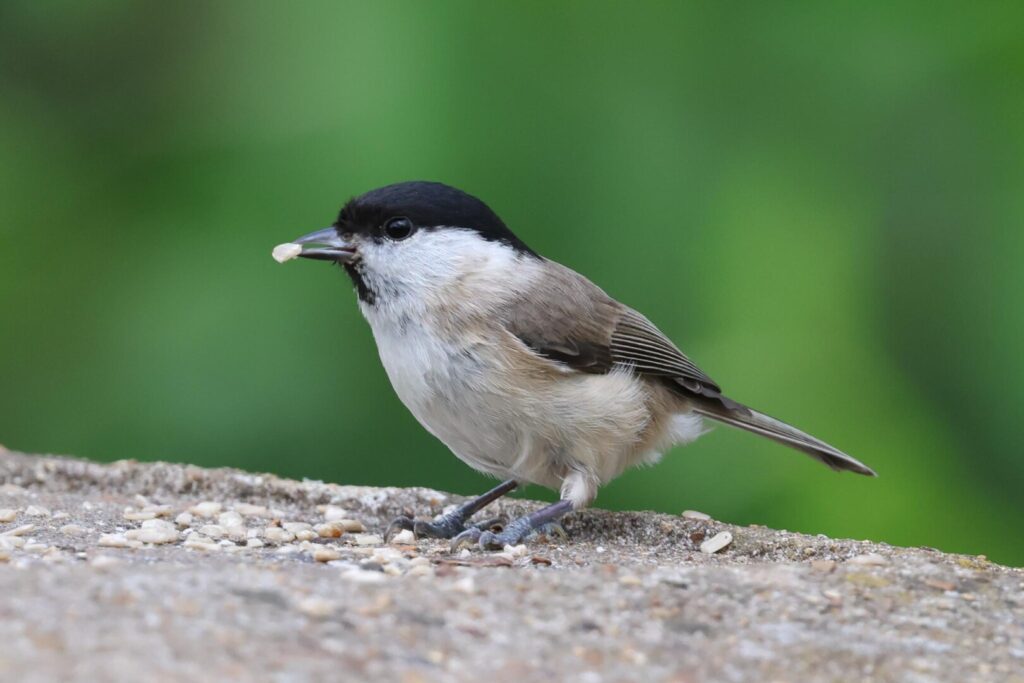
A nice way to round things off, we walked slowly back up to the car park where we said our goodbyes. It had been a lovely day full of Nightingales and the joys of spring in the Fens.
















